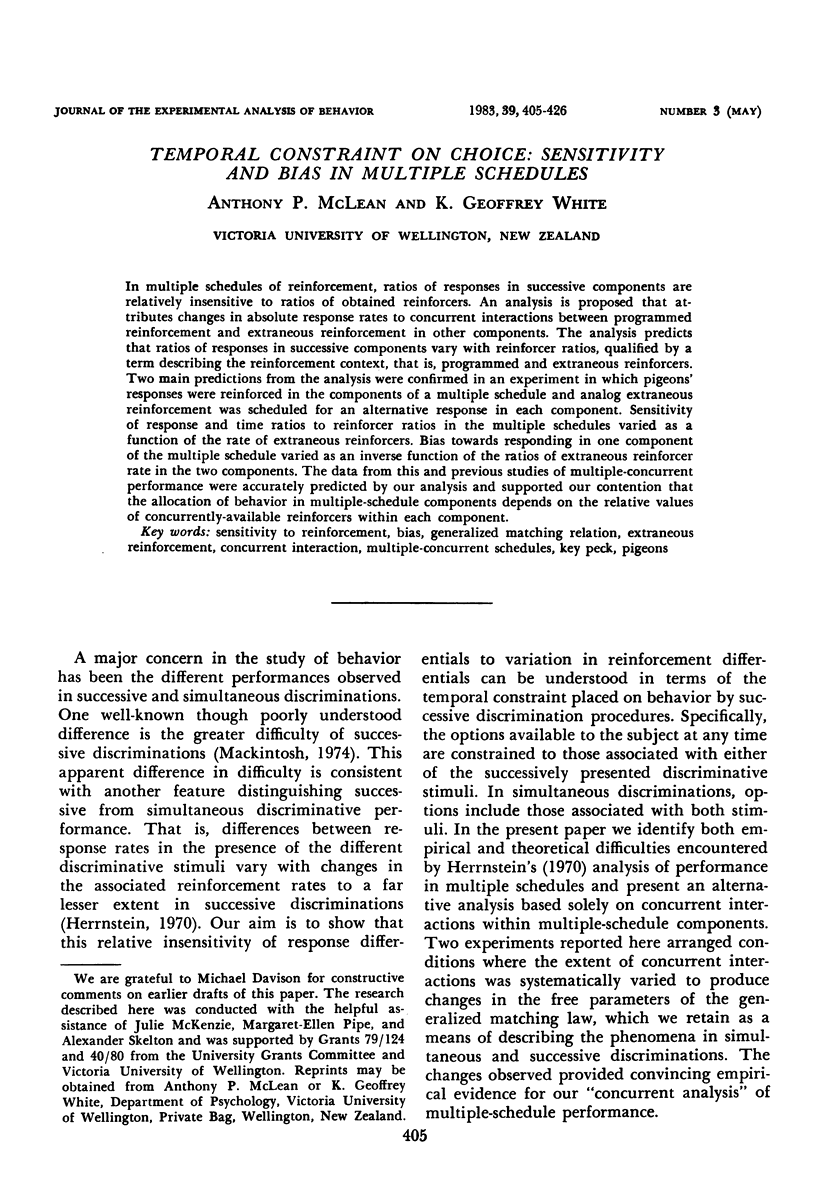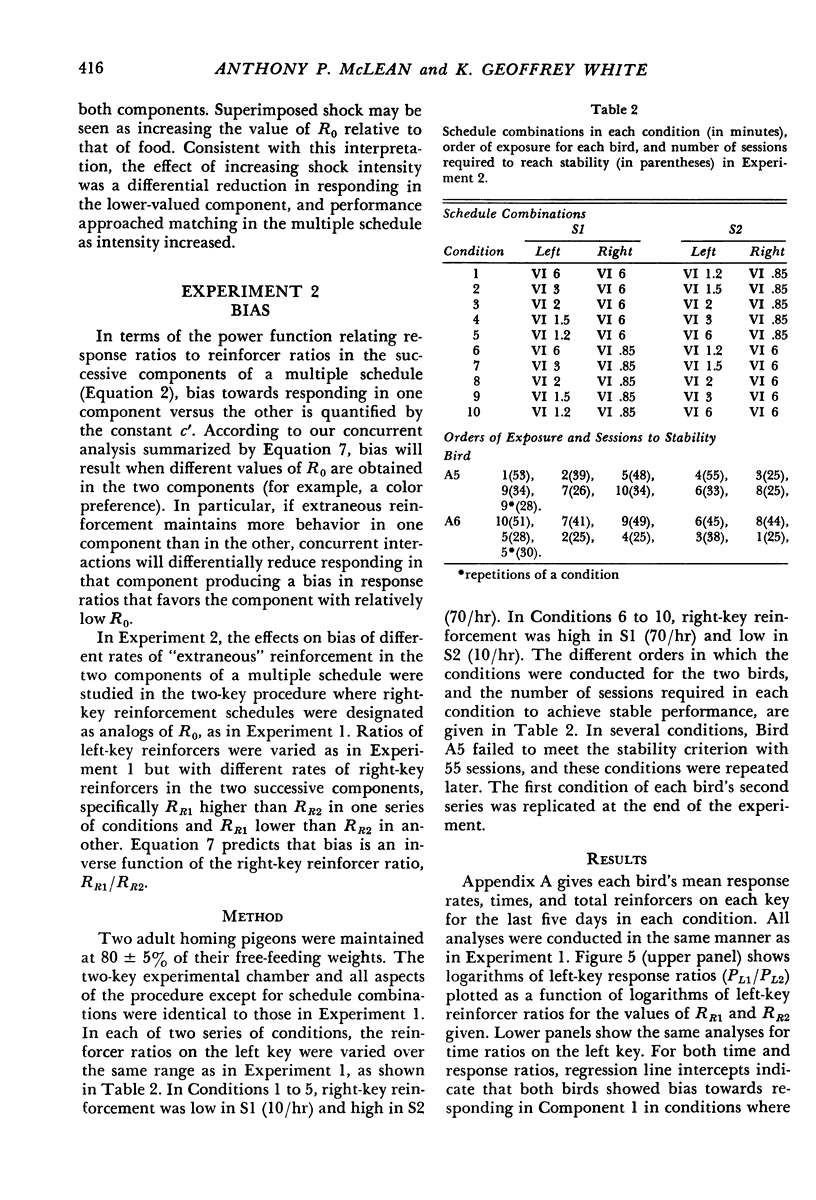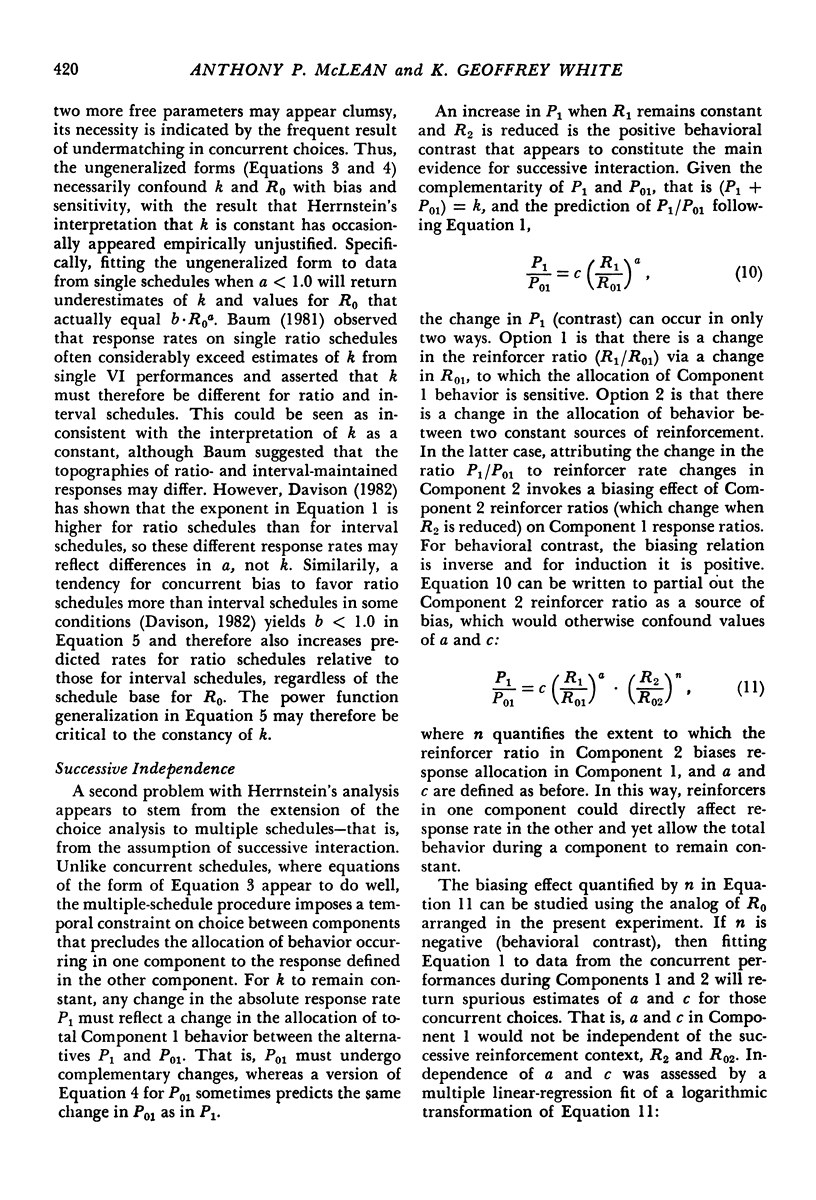Abstract
In multiple schedules of reinforcement, ratios of responses in successive components are relatively insensitive to ratios of obtained reinforcers. An analysis is proposed that attributes changes in absolute response rates to concurrent interactions between programmed reinforcement and extraneous reinforcement in other components. The analysis predicts that ratios of responses in successive components vary with reinforcer ratios, qualified by a term describing the reinforcement context, that is, programmed and extraneous reinforcers. Two main predictions from the analysis were confirmed in an experiment in which pigeons' responses were reinforced in the components of a multiple schedule and analog extraneous reinforcement was scheduled for an alternative response in each component. Sensitivity of response and time ratios to reinforcer ratios in the multiple schedules varied as a function of the rate of extraneous reinforcers. Bias towards responding in one component of the multiple schedule varied as an inverse function of the ratios of extraneous reinforcer rate in the two components. The data from this and previous studies of multiple-concurrent performance were accurately predicted by our analysis and supported our contention that the allocation of behavior in multiple-schedule components depends on the relative values of concurrently-available reinforcers within each component.
Keywords: sensitivity to reinforcement, bias, generalized matching relation, extraneous reinforcement, concurrent interaction, multiple-concurrent schedules, key peck, pigeons
Full text
PDF





















Selected References
These references are in PubMed. This may not be the complete list of references from this article.
- Baum W. M. Matching, undermatching, and overmatching in studies of choice. J Exp Anal Behav. 1979 Sep;32(2):269–281. doi: 10.1901/jeab.1979.32-269. [DOI] [PMC free article] [PubMed] [Google Scholar]
- Baum W. M. On two types of deviation from the matching law: bias and undermatching. J Exp Anal Behav. 1974 Jul;22(1):231–242. doi: 10.1901/jeab.1974.22-231. [DOI] [PMC free article] [PubMed] [Google Scholar]
- Baum W. M. Optimization and the matching law as accounts of instrumental behavior. J Exp Anal Behav. 1981 Nov;36(3):387–403. doi: 10.1901/jeab.1981.36-387. [DOI] [PMC free article] [PubMed] [Google Scholar]
- Bourland G., Miller J. T. The role of discriminative stimuli in concurrent performances. J Exp Anal Behav. 1981 Sep;36(2):231–239. doi: 10.1901/jeab.1981.36-231. [DOI] [PMC free article] [PubMed] [Google Scholar]
- Bouzas A. The relative law of effect: effects of shock intensity on response strength in multiple schedules. J Exp Anal Behav. 1978 Nov;30(3):307–314. doi: 10.1901/jeab.1978.30-307. [DOI] [PMC free article] [PubMed] [Google Scholar]
- CATANIA A. C. Concurrent performances: reinforcement interaction and response independence. J Exp Anal Behav. 1963 Apr;6:253–263. doi: 10.1901/jeab.1963.6-253. [DOI] [PMC free article] [PubMed] [Google Scholar]
- CATANIA A. C. Independence of concurrent responding maintained by interval schedules of reinforcement. J Exp Anal Behav. 1962 Apr;5:175–184. doi: 10.1901/jeab.1962.5-175. [DOI] [PMC free article] [PubMed] [Google Scholar]
- Catania A. C., Silverman P. J., Stubbs D. A. Concurrent performances: stimulus-control gradients during schedules of signalled and unsignalled concurrent reinforcement. J Exp Anal Behav. 1974 Jan;21(1):99–107. doi: 10.1901/jeab.1974.21-99. [DOI] [PMC free article] [PubMed] [Google Scholar]
- Charman L., Davison M. On the effects of component durations and component reinforcement rates in multiple schedules. J Exp Anal Behav. 1982 May;37(3):417–439. doi: 10.1901/jeab.1982.37-417. [DOI] [PMC free article] [PubMed] [Google Scholar]
- Davison M. C., Hunter I. W. Performance on variable-interval schedules arranged singly and concurrently. J Exp Anal Behav. 1976 May;25(3):335–345. doi: 10.1901/jeab.1976.25-335. [DOI] [PMC free article] [PubMed] [Google Scholar]
- Davison M., Ferguson A. The effects of different component response requirements in multiple and concurrent schedules. J Exp Anal Behav. 1978 Mar;29(2):283–295. doi: 10.1901/jeab.1978.29-283. [DOI] [PMC free article] [PubMed] [Google Scholar]
- Davison M. Preference in concurrent variable-interval fixed-ratio schedules. J Exp Anal Behav. 1982 Jan;37(1):81–96. doi: 10.1901/jeab.1982.37-81. [DOI] [PMC free article] [PubMed] [Google Scholar]
- FLESHLER M., HOFFMAN H. S. A progression for generating variable-interval schedules. J Exp Anal Behav. 1962 Oct;5:529–530. doi: 10.1901/jeab.1962.5-529. [DOI] [PMC free article] [PubMed] [Google Scholar]
- Findley J. D. Preference and Switching under Concurrent Scheduling. J Exp Anal Behav. 1958 Apr;1(2):123–144. doi: 10.1901/jeab.1958.1-123. [DOI] [PMC free article] [PubMed] [Google Scholar]
- HERRNSTEIN R. J. Relative and absolute strength of response as a function of frequency of reinforcement. J Exp Anal Behav. 1961 Jul;4:267–272. doi: 10.1901/jeab.1961.4-267. [DOI] [PMC free article] [PubMed] [Google Scholar]
- Herrnstein R. J. Formal properties of the matching law. J Exp Anal Behav. 1974 Jan;21(1):159–164. doi: 10.1901/jeab.1974.21-159. [DOI] [PMC free article] [PubMed] [Google Scholar]
- Herrnstein R. J., Loveland D. H. Hunger and contrast in a multiple schedule. J Exp Anal Behav. 1974 May;21(3):511–517. doi: 10.1901/jeab.1974.21-511. [DOI] [PMC free article] [PubMed] [Google Scholar]
- Herrnstein R. J. On the law of effect. J Exp Anal Behav. 1970 Mar;13(2):243–266. doi: 10.1901/jeab.1970.13-243. [DOI] [PMC free article] [PubMed] [Google Scholar]
- Hinson J. M., Staddon J. E. Behavioral competition: a mechanism for schedule interactions. Science. 1978 Oct 27;202(4366):432–434. doi: 10.1126/science.705334. [DOI] [PubMed] [Google Scholar]
- Lander D. G., Irwin R. J. Multiple schedules: effects of the distribution of reinforcements between component on the distribution of responses between conponents. J Exp Anal Behav. 1968 Sep;11(5):517–524. doi: 10.1901/jeab.1968.11-517. [DOI] [PMC free article] [PubMed] [Google Scholar]
- Lobb B., Davison M. C. Multiple and concurrent schedule performance: independence from concurrent and successive schedule contexts. J Exp Anal Behav. 1977 Jul;28(1):27–39. doi: 10.1901/jeab.1977.28-27. [DOI] [PMC free article] [PubMed] [Google Scholar]
- Lobb B., Davison M. C. Performance in concurrent interval schedules: a systematic replication. J Exp Anal Behav. 1975 Sep;24(2):191–197. doi: 10.1901/jeab.1975.24-191. [DOI] [PMC free article] [PubMed] [Google Scholar]
- McLean A. P., White K. G. Undermatching and contrast within components of multiple schedules. J Exp Anal Behav. 1981 May;35(3):283–291. doi: 10.1901/jeab.1981.35-283. [DOI] [PMC free article] [PubMed] [Google Scholar]
- McSweeney F. K. Positive and negative contrast as a function of component duration for key pecking and treadle pressing. J Exp Anal Behav. 1982 Mar;37(2):281–293. doi: 10.1901/jeab.1982.37-281. [DOI] [PMC free article] [PubMed] [Google Scholar]
- Mullins E., Agunwamba C. C., Donohoe A. J. On the analysis of studies of choice. J Exp Anal Behav. 1982 Mar;37(2):323–327. doi: 10.1901/jeab.1982.37-323. [DOI] [PMC free article] [PubMed] [Google Scholar]
- Myers D. L., Myers L. E. Undermatching: a reappraisal of performance on concurrent variable-interval schedules of reinforcement. J Exp Anal Behav. 1977 Jan;27(1):203–214. doi: 10.1901/jeab.1977.27-203. [DOI] [PMC free article] [PubMed] [Google Scholar]
- Nevin J. A. On the form of the relation between response rates in a multiple schedule. J Exp Anal Behav. 1974 Mar;21(2):237–248. doi: 10.1901/jeab.1974.21-237. [DOI] [PMC free article] [PubMed] [Google Scholar]
- Nevin J. A., Shettleworth S. J. An analysis of contrast effects in multiple schedules. J Exp Anal Behav. 1966 Jul;9(4):305–315. doi: 10.1901/jeab.1966.9-305. [DOI] [PMC free article] [PubMed] [Google Scholar]
- Pliskoff S. S., Shull R. L., Gollub L. R. The relation between response rates and reinforcement rates in a multiple schedule. J Exp Anal Behav. 1968 May;11(3):271–284. doi: 10.1901/jeab.1968.11-271. [DOI] [PMC free article] [PubMed] [Google Scholar]
- REYNOLDS G. S. Behavioral contrast. J Exp Anal Behav. 1961 Jan;4:57–71. doi: 10.1901/jeab.1961.4-57. [DOI] [PMC free article] [PubMed] [Google Scholar]
- Rachlin H. A molar theory of reinforcement schedules. J Exp Anal Behav. 1978 Nov;30(3):345–360. doi: 10.1901/jeab.1978.30-345. [DOI] [PMC free article] [PubMed] [Google Scholar]
- Rand J. F. Behaviors observed during S- in a simple discrimination learning task. J Exp Anal Behav. 1977 Jan;27(1):103–117. doi: 10.1901/jeab.1977.27-103. [DOI] [PMC free article] [PubMed] [Google Scholar]
- Shimp C. P., Wheatley K. L. Matching to relative reinforcement frequency in multiple schedules with a short component duration. J Exp Anal Behav. 1971 Mar;15(2):205–210. doi: 10.1901/jeab.1971.15-205. [DOI] [PMC free article] [PubMed] [Google Scholar]
- Spealman R. D., Gollub L. R. Behavioral interactions in multiple variable-interval schedules. J Exp Anal Behav. 1974 Nov;22(3):471–481. doi: 10.1901/jeab.1974.22-471. [DOI] [PMC free article] [PubMed] [Google Scholar]
- Todorov J. C. Component duration and relative response rates in multiple schedules. J Exp Anal Behav. 1972 Jan;17(1):45–49. doi: 10.1901/jeab.1972.17-45. [DOI] [PMC free article] [PubMed] [Google Scholar]
- White K. G. Behavioral contrast as differential time allocation. J Exp Anal Behav. 1978 Mar;29(2):151–160. doi: 10.1901/jeab.1978.29-151. [DOI] [PMC free article] [PubMed] [Google Scholar]


